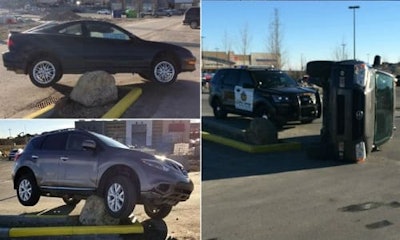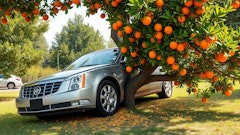
By Jeff Sanford
Toronto, Ontario — December 8, 2017 — In this week’s edition of Friday Fun, a problematic rock becomes famous for Calgary accidents, a collision repair shop refinishes the Christmas spirit, a major expose of auto accident injury assessment centres, and much, much more.
-Police in the UK have seized a car after the driver claimed he had no insurance because there was “no place to buy insurance on a Sunday.” The police weren’t buying it and the vehicle was confiscated, according to a report from ITV News.
-A certain parking lot in Calgary became famous this past week. Cause of all the attention: A large rock, which is causing a lot of accidents lately. A local story from CBC News published this past week describes how this giant rock in a suburban parking lot managed to become a social media star. The large rock is part of a retail-shopping complex being developed in a new community.
Part of the landscaping in the new parking lot, the rock has caught up at least three vehicles. Local residents have now ended up calling it Sage Hill Rock. Someone even made a Facebook page for the rock. The page has posted at least three cars that ended up in accidents after getting caught up on the awkwardly placed stone. According to the media report, “An employee of the nearby bottle depot, which opened in mid-October, said the rock was placed there to prevent motorists from driving over the curb but it’s now going to be removed by Riocan, the company that manages the retail complex.” The string of incidents has become a bit of a running joke in Sage Hill according to the report. A source in the story is quoted as saying, “To be honest, this kind of made our weekend. I was very surprised at how many people were into the Sage Hill Rock.”
-The owners of a collision repair centre in the US known as Cloot’s Auto Body have re-varnished their holiday spirit. The shop saw its holiday decorations destroyed over the Thanksgiving holiday weekend (which was just two weeks ago in the U.S.). According to 22News, the shop is famous for the decorations it puts up for every major holiday. But after vandals slashed a number of inflatable displays outside of the shop, the owners were so disheartened that they decided not to decorate for Christmas this year.
That’s when locals stepped in to save the holiday spirit. According to the local report, “… over the last few days, donations and notes have come in to support the Christmas decorations, and people have even started stopping by to decorate the Cloot’s truck themselves.” The owner of the shop is quoted as saying; “It just puts a smile on your face and restores your faith in humanity. It’s heart warming to have people come in and do that on their own, because they feel terrible about it and they want to see the truck continue to be decorated.” Tragedies such as these can bring out the best in a community, which reminds us all that really, it’s a wonderful life.
-Neil Young is famous for his music, but he’s also known for collecting cars. Over the decades he has put together a collection of big American cars from the 1950s. Some of them go on sale this weekend. This Saturday, Dec. 9 at Julien’s Auctions in Los Angeles, Young will be auctioning some of the cars, along with some guitars. Vehicles up for sale include a 1953 Buick Roadmaster and a 76X Skylark Convertible (a model known as “the holy grail of classic Buicks”). A report on the auction in the auto trade press notes that the Buick sports a 188-hp, 322-cubic-inch nail head V8, “which replaces the previous straight-eight.” The VIN is also special, No. 1 of 1,690 made that year. The auction house expects the car to sell for between $200,000 and $300,000. Also up for sale is a 1941 Chrysler Series 28 Windsor Highlander two-door three-person coupe and a 1948 Buick Road master hearse, similar to the one Young drove to L.A. in the early 1960s.
-The latest Lamborghini represents a new direction for the company. The new model, an SUV, may mark a turn at the exotic carmaker toward a more conventional future. Several media reports note the body makes use of a lot of aluminum, but not much carbon fiber, which is a frequently used material in the company’s high-end vehicles.
According to a media report, “The chassis is a blend of aluminum and steel, with frameless aluminum doors, torsional beams replacing a C-pillar, and cross-members in aluminum contributing to the lightweight Urus, as does the chassis floor in a high-strength steel material.” Light weighting brings the SUV down to a curb weight of 4,850 pounds according to Automotive News Europe. The report also notes that “for the first time” the company will do its own painting in-house. According to the story the OEM expects to, “… produce between 3,500 and 4,000 Uruses worldwide per year — which would be more units than the entire company sold in 2016.” The CEO of the company was quoted as saying, “With the Urus, Lamborghini is not only entering a segment that is completely new to our brand, we are also doubling the output of our company.” Read more about the Urus here.
-A major report in the Globe and Mail newspaper takes a deep dive into the assessment firms that insurance companies run to manage the case of auto accident victims. The story appeared this past week, just before Liberal minister Charles Sousa announced the government was ending the “fraud” that had become an “industry” among the lawyers and doctors acting in medical cases concerning accident victims.
The story makes the case for the minister to be so bold in his comments. Some of the details in the major report are shocking. The investigation seems to be widely shared on social media. The major take of the Globe reporters is this: The insurance companies, through assessment firms, “… altered and ghostwrote accident victim reports,” in the favour of the insurance companies. Some of the doctors working for the assessment firms have depended for decades on this work. It seems some have ended up catering to the interest of those paying the bills in these cases.
The story quotes several sources that have ended up losing homes and livelihoods after the assessment firms claimed victims were fine to resume physical work, “… despite ample evidence to the contrary.” The story relates the case of one victim who complained to the Ontario College of Physicians and Surgeons that the physiatrist on their case seemed to be writing the assessment to benefit the insurer.
According to the Globe report, “The regulator chastised the doctor for a ‘lack of clarity’ in statements ‘not as carefully set out as they should have been’.” According to the source in the story, “[The assessment firms] go to great lengths to say there’s nothing wrong. The people benefiting from all of this are the lawyers and the doctors that are involved.” Other details from the lengthy feature:
- “Hundreds of Canadian physicians have signed on with several assessment companies to put their names to IME reports. The companies’ physician rosters, obtained by The Globe, show most only do ‘paper reviews’ of medical files and never see the accident victims.”
Sources have found mistakes in records, including wrong MRI reports in files. - “Judges hearing auto insurance disputes have called some of the fees assessment companies charge extravagant… For example, a judge in another case took issue with a $12,600 bill for the services of one physician. It included a $6,300 ‘cancellation fee’ for a court appearance the doctor didn’t have to attend, plus a $2,000 administrative fee tacked on by [an assessment provider].”
- “A review of several cases shows assessment firms often provide fill-in-the-blank templates for medical professionals to use as a basis for their reports.”
- “A recent Ontario court case revealed that a ‘quality assurance’ person with an assessment company compiled four pages of a report, using a template, on a seriously debilitated car accident victim. The company then gave the completed section to an occupational therapist to cut and paste into her assessment. The doctor admitted in court she compiled and signed that report without changing the part the company wrote or doing any cognitive testing on the victim. The report concluded he had no cognitive impairments, in stark contrast to every other medical opinion.”
- “In a B.C. case last year, a judge rejected a report from a physiatrist, which admitted that an associate wrote the first eight pages. The report concluded the victim had no injuries related to the accident. The doctor admitted he spent only 15 minutes with her, on a day when he did 10 such assessments. Ghostwriting is now a serious enough concern that, in one case, an Ontario judge recently ordered a medical assessment must be written by the doctor, not ‘partly written by administrative staff or other individuals,’ adding that ghostwriting ‘wreaks havoc’.”
- “A second judge followed suit this year. He also raised serious questions about the overwhelming majority of reports that never get to court, stating: ‘The real danger is, what about the cases that were settled based on the expert’s opinion as stated in the report without ever going to trial? The parties, counsel or the court at a pre-trial would never know if it was solely written by the author of the report or not’.”
- “It appears questionable practices have been going on for some time. Eleven years ago, an assessment company rewrote portions of [a] report by another physiatrist without his knowledge, making it more favourable to the insurance company. The final report, which was never seen by the doctor, was signed with a stamp of his signature. A judge called it ‘unwarranted and undesirable interference’.”
- In another case, “… an occupational therapist discovered a company had altered a report.” When the accident victim filed a complaint to the therapist’s regulator, the doctor told her regulator she had no idea the report had been changed. “The investigation proved that the report filed by the therapist was different from the final [report] sent to the insurance company. “The regulator determined that the report had “factual errors” and had an ‘egregious impact’ on the victim, who was denied insurance coverage.”
The findings are startling to say the least.




















